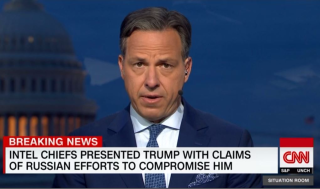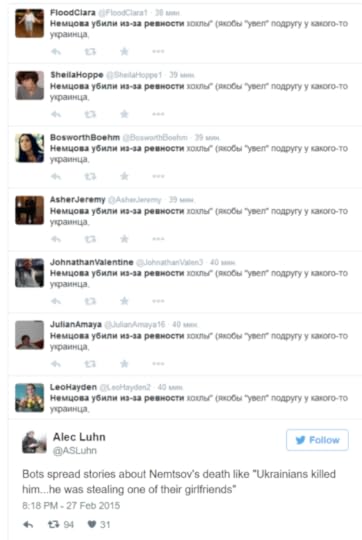John Robb's Blog, page 6
January 19, 2017
Will the World be Safer or More Dangerous Under a Trump Presidency?
With Trump's inauguration tomorrow, I thought this thinking might be useful.
____
I was on a panel at the always insightful Suits and Spooks conference in Washington DC last week (it's an eclectic mix of IC pros and cybersecurity execs from around the world). It was lots of fun. The topic of discussion on my panel was the title of this post: will the world be safer or more dangerous under a Trump presidency?
One of my answers was a simple, synthetic (as opposed to analytic) framework for understanding Trump's foreign policy:
Since WW2, US foreign policy has been completely dominated by national security policy. In fact, it's hard to imagine a US policy that doesn't view the world through a militaristic, cold war lens. This means that ALL other aspects of foreign policy are conducted in support of (slaved to) national security policy. In particular, US trade policy is configured to promote the economic growth of allied nations (originally to fight the cold war) even if this trade relationships damages US economic performance.
Trump inverts that policy relationship. In Trump's post cold war world, US foreign policy will be dominated by trade policy. Even national security policy will be subservient to trade policy. If trade policy is dominant, we'll see China, Mexico and the EU (Germany) become competitors. Russia, in contrast will become an ally since it doesn't pose a trade threat.
National security under this regime will be used to reinforce and grow positive trade relationships. For example, military tension with China creates the opportunity for sanctions that simulate the function of tariffs (allowing the US to circumvent trade organizations and domestic resistance to tariffs). In a national security policy slaved to trade, any and all security guarantees extended to other nations will require a positive trade arrangement with the US. The US simply won't protect or extent security guarantees to any nation that has a non-beneficial economic relationship with the US (i.e. runs a trade deficit).
This may or may not be useful to you.
I find it useful since it has proven to be fairly good at predicting where Trump and his bros are careening towards next.
Sincerely,
John Robb
PS: Synthesis works better than analysis in complex, rapidly changing environments like this.
PPS: This trade centric approach suggests growth in naval spending.
January 18, 2017
Botting Politics
During the 2012 US Presidential election, the Romney campaign was accused of buying fake Twitter followers from a bot network after he gained a whopping ~150,000 new followers in one day. Romney's following jumped 17% in one day, providing him with a significant bump in the general perception of his grassroots popularity and support for a paltry ~$2,700 ($18 per thousand followers).
 Despite the accusation, the astroturfing effort worked. Few saw, read, or cared the report that claimed these followers were bots and not people. Since 2012, there's been a significant increase in the use of political bots in nearly every country in the world, from Afghanistan to Venezuela. Most of these early efforts, usually done in support of the government or establishment, fall into the following categories:
Despite the accusation, the astroturfing effort worked. Few saw, read, or cared the report that claimed these followers were bots and not people. Since 2012, there's been a significant increase in the use of political bots in nearly every country in the world, from Afghanistan to Venezuela. Most of these early efforts, usually done in support of the government or establishment, fall into the following categories:
Support padding (like Romney)
Disseminating or amplifying propaganda (Saudi Arabia does lots of this)
Demobilizing or trashing protest movements (flooding hashtags for example)
Swarmed Mass
Most of these early political bots are used in large swarms. Swarms that allow them to act as a single unit to overwhelm the opponent with mass. In some cases, the swarm is used to repeat a message again and again to increase its influence (retweeting, reposting, etc. en masse). In others, it's used to flood an opponent with a large volume of responses refuting their claims.
To really get a sense of this, let's look at a single Russian swarm (out of many) that was used to pump kompromat and demobilize the opposition inside Russia. Botnet swarms like this flood any negative post, story, or tweet on a particular topic with pushback and amplify the dissemination of kompromat across social networks.
After the shooting of Boris Nemtsov in 2015, this botnet sprang into action claiming that the Ukrainians shot him:
By using the breadcrumb trail of identical posts, Lawrence Alexander used social networking analysis tools to map out the swarm. The result was a tightly interconnected network of 2,900 bots acting in concert to demobilize opposition and promote kompromat.
Big, crude swarms like this are already losing effectiveness as the social networking companies get smarter about detecting and banning them. Naturally, this has created an arms race between bot makers and the social networking companies, but with a twist.
The twist is that most governments aren't on the side of the social networking companies. Most are working on bot networks that circumvent controls in order to influence and control political opinion just like everyone else.
Sincerely,
John Robb
PS> Bots come in two flavors:
software or
a combination of software and hardware (robots).
While hardware based bots like drones have some scary/amazing (yet largely unexplored) tactical utility, most of the real action is in software bots or more specifically, social bots. Social bots can be run from a single computer using multiple social networking accounts. Others are operate as a network, using PCs compromised by malware. In general, social bots can do the following:
automate and amplify interaction with social networks.
can converse with people (chatbots, customer service bots, etc.) -- some of these are getting amazing.
actively and remorselessly troll, harass, and confuse opponents.
Obviously, all of these attributes make social bots extremely useful politically.
January 17, 2017
Our Addiction to Kompromat
Russia has two exports: energy and kompromat. Since energy isn't nearly as valuable as it was a decade ago, Putin has increased Russia's production of kompromat to compensate. So far, he's been fairly successful with this, but for an unexpected reason.
What is kompromat? Kompromat is any material that can be used to discredit, mislead, blackmail, coerce, or confuse a targeted person or entity. This material spans the gamut, from a leaked sex video to a financial document proving corruption. In short, any material can be used as long as it is effective at damaging an opponent.
However, kompromat proved to be something more than simply as a way to deal with the occasional political enemy. Over time, it became clear that in a networked Russia, a steady flow of targeted kompromat was actually capable of keeping the nation's entire social fabric in a perpetual state of turmoil. A turmoil that enabled Putin to remain in power with much less authoritarian repression than would have been needed before Internet networking.
Of course, Russia isn't alone in its addiction to a steady diet of kompromat, deception, and fake narratives. Endless socioeconomic stagnation has led the US and the EU to developed similar addictions. Addictions that erupted in full force over the past year with an amazing ferocity.
The intentional disruption of social networks is now part of the political mainstream in the US (and increasingly the EU), and it took only one election cycle for the entirety of the political spectrum to adopt it. Now, salvos of intentional disruption are the most common form of political discourse in the increasingly fractured west.
 Every participant in our political system is doing it. In fact, there is so much domestically produced and self inflicted social disruption going on now, by so many participants, Russia's attempts at US kompromat are below a rounding error in comparative effectiveness.
Every participant in our political system is doing it. In fact, there is so much domestically produced and self inflicted social disruption going on now, by so many participants, Russia's attempts at US kompromat are below a rounding error in comparative effectiveness.
Given this backdrop of increasing disruption, I'm continually surprised that establishment organizations and figures are actively engaged in it to damage Trump. For example, the recent ongoing campaign by senior members of the intelligence community to use leaked kompromat to cast doubt on the Trump's legitimacy by tying him to Putin.
Disruption like this does more harm than good to the establishment. Trump is the incredible Hulk of disruption. The more you throw at him, the stronger he gets. In contrast, the establishment derives its power through the smooth functioning of the system and strong connections.
Anything that weakens, disrupts, negates, or damages the system makes it easier for Trump to operate and harder for the establishment to do the same.
Sincerely,
John Robb
January 16, 2017
The Race to Weaponize Empathy
There's a war for the future being waged online. It's being fought across the world's online social networks, and the outcomes of these online battles increasingly dictate the outcome of what happens later in the real world.
One of the most successful tactics used in this war is the manipulation of language in order to confuse, scare, nullify or outrage targeted audiences with the objective of making money, aggregating political power, and disrupting opponents.
While this manipulation has ALWAYs been true of human conflict, it's being done on a scale and to a degree that we've never seen before due social networking, globalization, and social/media fragmentation.
A great example of tactical manipulation called the the Russell Conjugation (or the "emotive conjugation" championed by the philosopher Bertrand Russell , the pollster Frank Luntz and recently Thiel Capital's Eric Weinstein).
The Russell conjugation exploits the gap in the emotional content of a word or phrase and the factual content. Here are a few of Russell's examples:
"I am firm; you are obstinate; he is a pig-headed fool."
"I am righteously indignant; you are annoyed; he is making a fuss over nothing."
Notice how the factual content remains unchanged. In each case, the person referenced is factually described as "a person who is reluctant to accept new information." However, the words used change the emotional content drastically, from a positive to neutral-negative to negative-opprobrium.
The ability to change the emotional spin on a fact is critical. As all great marketing pros already know, the emotional content of a message is much more important than the factual content when it comes to selling anything. All brands are simply emotion (a commercial brand is monetized emotion).
However, this gets more complicated when an emotional spin is applied to facts presented as news. As Weinstein correctly points out, people don't just care about the factual content since they don't view a fact as a bit of disconnected information. They see all facts within a social context and that context is identified by the emotional context attached to that fact.
In fact, if historical behavior is a guide, people care more about the social consequences of the facts than the fact itself.
We've seen this before. Context seeking is also the basis of consumerism as Thorstein Veblen pointed out in his classic book on modern economics The Theory of the Leisure Class. Simply, the entire modern economy is based on people buying products and services in an attempt to mimic the choices and habits of people they consider cooler, wealthier or more successful than they are.
This is also true with news in a fragmented society. Most people go to news sources they trust to find out more than the facts. They want to find out how they should feel about a fact (or whether they should reject that fact) from people they consider to be leaders of their social network.
This context seeking used to be limited to the news presented by reporters/editors of the big papers like the New York Times and the TV network news organizations like CBS. That's not true anymore. Control over the emotional content of news has fragmented due to the rise of social media and social networking. People don't just look for the "correct" emotional spin on a fact from a big media company, they seek it from alt news orgs and personalities on social networks they identify with.
This suggests that the current debate over "fake news" isn't due to the use of fabricated information. Instead, it's really a negative way of describing news that has an emotional context that is at odds/war with the emotions approved by the major media, academia, or government.
Sincerely,
John Robb
PS: Here's a good book from Frank Luntz on how this manipulation works in practice. Example: how the Estate Tax was redeemed by calling it the Death Tax and Illegal Immigrants were redeemed by calling them Undocumented Immigrants.
December 15, 2016
The US is Officially a Banana Republic: the CIA is trying to topple the Government
There's an electoral coup underway.
The number of potentially faithless Republican electors is now up to 50, more than enough to deny Trump the votes he needs for an EC win and/or give Hillary Clinton the votes she needs to win.
The stealth effort, led by liberals who believe Trump is a danger to the US, has been underway since the election.
That effort only gained traction with Republican electors when the CIA leaked that Russia had intervened in the US election to help Trump win.
Of course, the timing of the CIA's leak wasn't random.
It was something much more sinister. It was an opening salvo by the CIA to actively influence the Electoral College and stop Donald Trump from becoming President.
In other words, the CIA is trying to topple Trump.
Why? Self preservation.
The real reason is that Trump was working with Peter Thiel to corporatize the intelligence gathering of the United States around companies, like Palantir, that can adopt and employ technology much faster and with more efficacy. In other words, Trump is planning to turn the CIA and the NSA into peripheral collection systems.
That was unacceptable to the CIA, an agency with a strong sense of self-importance.
They acted again today when the head of the CIA refused to brief the House Intelligence Committee on the their claims because the chairman of the committee, Devin Nunes, was part of Trump's transition team.
Instead, the CIA leaked more information this afternoon to influence electors:
"new intelligence shows that Putin personally directed how hacked material.. was leaked"
However, due to tight legal restrictions on how the use of the information the CIA gathers and who it gather it on (i.e. US citizens), I anticipated that any new leak would be from allied sources not covered by these restrictions.
That proved to be correct:
"The intelligence came from diplomatic sources and spies working for U.S. allies."
What's next?
We can expect to see more leaks this weekend, before the EC votes on Monday.
What kind of info? A shred of evidence (a taped conversation would be best), gathered by US allies and not the CIA, that shows that Trump knew about the hack or came to an agreement with Putin.
At that point, the EC will definitely flip and Trump will be denied an electoral college win on Monday.
After that we head to the courts and start down the road to street level violence.
To avoid the chaos of merely unseating Trump, the electors may award Hillary Clinton the win since she is best able to gather the establishment around her to fight off Trump's bid.
Regardless, we have moved another step towards what looks more and more like another US civil war.
It's not a long trip, now that we are a Banana Republic.
Sincerely,
John Robb
December 12, 2016
WARNING: An Electoral Coup is Underway
On December 19, 2016 the electoral college will vote.
Based on the vote, Trump should receive 306 votes and Clinton will have 232.
However, it is possible for many electors to change their vote. They aren't bound by it.
There's currently a very well funded attempt to influence electors to flip their votes on December 19th to change the outcome of the election.
Despite expectations that it is far fetched, it has a high chance of success. As of today, there are enough electoral votes in play to flip the outcome.
The three outcomes in discussion right now:
Trump falls short of the electoral count (270) to become President and the election is sent to Congress for a decision.
Clinton gets more than 270 electoral votes and becomes the President.
A dark horse candidate (Kaisitch, etc.) would get the votes to become President.
In my view: all of these outcomes would end in a disaster.
Why? Most of the country sees this election as already decided.
The voters have spoken. Any change the outcome of the election at this juncture would be widely seen as illegitimate.
What would happen next would be worse.
Trump would claim this is a coup d'etat and gather widespread support. Most of the states (which are Republican dominated) would support him on this.
Until January 20th, chaos would ensue. Violent conflict would be widespread as groups (pro or against Trump) form and take action.
I haven't fully gamed this out but I suspect Trump would be able to gather enough support to become President regardless of the electoral college result (anything less would result in a messy street level civil war). Fear of continued chaos would force this.
The moment he is sworn in, he would invoke a state of emergency and quickly move to arrest anyone connected with the plot to nullify the election and anyone calling for violence.
By the end of March, thousands of people could even find themselves in Guantanamo. -labelled as terrorists/traitors they would be denied access to legal representation or any outside contact until the emergency is over.
Trump, strengthened by emergency powers and without an effective opposition (fear of being put on a list), would now be able to rule as a semi-dictator.
Why Clinton Lost: An exercise in victimology
For those of you not watching the aftermath of the election carefully (or you live outside of the US), here's a list of "popular" reasons for why Clinton unexpectedly lost the election to Trump according to the establishment.
Reason #1: The media built up Trump. They gave him billions of $ in free coverage.
Reason #2: The media didn't do its job. It didn't hold Trump accountable for his lies and fabrications.
Reason #3: Fake (right wing) news on social media influenced low information voters (anyone who votes Republican).
Reason #4: The FBI sabotaged Clinton with the Comey letter (particularly its timing).
Reason #5: A deeply racist, sexist (worse: misogynist), and homophobic country influenced by Trump "dog whistles" voted for him.
Reason #6: The Alt Right (the online face of NeoNazis, the KKK, etc.) is large, growing (fast), and influential enough to swing the election.
Reason #7: The Russians hacked the election (via Wikileaks and fake news).
Reason #8: Jill Stein and the people who voted for her. Gary Johnson and the people who voted for him.
Reason #9: Hillary didn't lose. She won (the popular vote) by a landslide, but our system is rigged by an antiquated electoral system.
Reason #10: Betrayal. The youth vote didn't show up. The black vote didn't show up. White women (53%) and Hispanics (29%) didn't vote the way they were supposed to.
Reason #11: Republican voter suppression in North Carolina, Pennsylvania, Michigan and Wisconsin (via @davewiner )
Reason #12: The voting process in MI, WI, and PA was hacked (Jill Stein et. al.).
Reason #13: The country was not ready for a woman president.
Reason #14: Polsters and big data geeks working for the media misled voters by claiming Trump couldn't win. As a result, enthusiasm waned and voters didn't show up.
Reason #15: A poorly run campaign that made poor decisions based on faulty data driven analysis (a result which largely discredits the new book by Michael Lewis).

November 11, 2016
Trump's Insurgency creates our Tahrir Square Moment
This year, an open source insurgency formed in the US and it took control of the White House. I didn't write much about it this fall because it hit too close to home. I knew what would happen.
What is an open source insurgency? An open source insurgency is how a very large and very diverse group of people empowered by modern technology and without any formal organization, can defeat a very powerful opponent.
I first started writing about open source insurgencies during the war in Iraq over a decade ago. During that war, over 100 insurgent groups with different motivations for fighting (tribal interests, pro-Baathist, pro-nationalist, pro-Saddam, and lots of jihadi flavors) used the dynamics of open source warfare to fight a global superpower to a standstill. We saw it again a few years later in the political world, when during the Arab Spring an open source fueled protest toppled governments in Tunisia, Egypt, Libya and Syria.
Open source insurgencies and protests can arise spontaneously and they are very hard to stop once they get going since they are impervious to most forms of repressive counter-attack and political subversion. For example, the open source movement propelling Trump forward made him impervious to attacks on his character. It also eliminated any need for "ground game" or standard political organization and obviated any need for information disclosure and detailed policy papers.
Of course, that doesn't mean you can't defeat an open source insurgency. You can, but it requires a different approach. For example, here's a simple idea for how to defeat Trump's insurgency back in July:
IF Trump is running an open source insurgency, you don't go after the man to defeat him. Attacking him directly won't work. He's impervious to attack. One reason is that a good 60% of America has been lied to so much by the establishment, they don't believe anything they say anymore. The way you beat him is to cleave off part of his movement. In this case, given the dynamics of the movement and this election, the best group to bring back are working class families in the midwest swing states. To bring them back you need to do something real. Not promises (seen as lies). You need to actually do it. In this case, the best approach is to put the President, the Congress, and most big US companies together in a room and over the course of two weeks and nail down a deal to bring back 1 million real jobs to MI, OH, and PA. -- with real timelines for implementation, good incomes and real benefits. If they do that, this election is over.
If you have been reading me for a decade (or more), you might notice that this thinking is similar to what I wrote as an op-ed in the New York Times in 2005, as a way to win the war in Iraq.
Two years later, this approach became the strategy that let the US extricate itself from Iraq. Regardless, Trump is in the White House and the success of open source insurgency guarantees we will see more of them in the future...
Perhaps sooner rather than later.
My worry is that the next one we see won't operate within the confines of a political campaign. This uptick in insults directed at minorities blamed on Trump, may be the tinder for setting off this next insurgency. Social media amplifies every incident, spreading the anger it evokes like contagion across the country. Just watch. This suggests that the next open source protest we are likely to see will form to force Donald Trump from the Presidency before the next election -- a Tahrir square moment in cities all across the US. A massively and diverse open source protest that has one simple goal: the immediate removal of Donald Trump from office.
Unfortunately, an open source insurgency that forces a sitting President from office without the benefit of an election could result in the same outcome as Egypt (or worse Syria).
Sincerely,
John Robb
PS: For more: here's some more thinking on how to start one. The IEEE Spectrum has a primer on open source warfare. My book is probably the definitive source for it.
September 4, 2016
The Terrorism Tax hits Europe
This is big news. This is the first large scale demonstration that the "Terrorism Tax" I speculated about back in 2004, actually works.
______________
Liz Alderman at the NYTimes reported that terrorism is squashing Europe's first glimmer of recovery since the financial crash. EU economic growth has been halved since spring, with France now at zero. Here are some details:
Tourism is sinking. For example: "In France, growth in nightly hotel room bookings after the Paris attacks fell to single digits from 20 percent. After the Brussels bombings, bookings went negative, and after Nice, bookings fell by double digits."
Daily security costs are spiking. Here's an example from a single venue, "the Paris Plage, a makeshift beach erected along the Seine, a dozen armed police officers guarded an entry checkpoint on a recent day. Army troops marched past families playing in the sand and half-empty activity points along the river. The patrols, cost taxpayers about 1 million euros, or $1.1 million, a day."
Broad spectrum economic damage. For example: retail sales are slumping due to low traffic in stores and large numbers of entertainment events are being cancelled.
The Terrorism Tax
Although Europe has suffered terrorism before, this time it's different. Instead of big and relatively infrequent terrorist attacks, these new attacks are small, numerous and geographically dispersed. This change is a big deal, because it makes it possible for terrorists to turn attacks into "a tax" that depresses economic activity by imposing new costs and changing economic behavior. Here's some of the theory from my 2004 article on it:
A terrorism tax is an accumulation of excess costs inflicted on a city's stakeholders by acts of terrorism. These include direct costs inflicted on the city by terrorists (systems sabotage) and indirect costs due to the security/insurance/policy/etc. changes needed to protect against attacks. A terrorism tax above a certain level will force the city to transition to a lower market equilibrium (aka shrink). So, what is that level? Here's what they concluded:
Singular terrorist events (black swans), like 9/11, do not impact city viability. The costs of a singular event dissipate quickly. In contrast, frequent attacks (even small ones) on a specific city can create a terrorism tax of a level necessary to shift equilibriums.
In the labor pooling model of city formation, a terrorism tax of 7% will cause a city to collapse to a lower equilibrium. Labor pooling equilibrium reflects the benefits of aggregating workers in a single location. Workers get higher wages and more choices. Firms get stable wages (no one firm can deplete the market) and more candidates.
In the core-periphery model of city formation, a terrorism tax of 6.3% will push a city to a lower equilibrium. The core-periphery model is based on transportation costs. Firms generate transportation savings by concentrating in a single location next to suppliers and customers. Customers and workers glean the benefit of lower transportation costs by locating near jobs and goods.
________
The terrorism tax is even more effective when it is combined with systems disruption (the intentional disruption of infrastructure). That combo puts in play hidden dynamics - both economic and societal - that can turn a functional society into a violent insurgency within months.
August 30, 2016
The FAA vs. the Future
The new FAA rules (part 107) for the commercial use of drones are now in force.. Let me summarize them for you in a single picture:
The FAA rules (needed) are not only years late, they contain a major flaw.
It's a flaw so large, it's similar to regulating cars with the rules used for horse drawn carriages. You can see this flaw in the rules they are proposing:
Visual line-of-sight (VLOS) only; the unmanned aircraft must remain within VLOS of the remote pilot in command and the person manipulating the flight controls of the small UAS.
A person operating a small UAS must either hold a remote pilot airman certificate with a small UAS rating or be under the direct supervision of a person who does hold a remote pilot certificate (remote pilot in command).
No person may act as a remote pilot in command or VO for more than one unmanned aircraft operation at one time.
See the flaw yet?
The flaw is that the FAA's commercial drones require a pilot at the controls. A pilot!
Really?
The fact is, as a professional pilot, I can tell you categorically that drones don't need a pilot. Not inside the aircraft or on the ground with a controller. They can fly on their own.
You can see this in how they developed. Drones only became a disruptive technology the moment that low cost computer chips exceeded the intellectual capacity of insects in 2011. They didn't become disruptive due improvements in the batteries, motors, and materials used to build them. These new chips make drones smart enough to do everything insects (flies, bees, etc.) do. That means they don't need pilots to:
Stabilize themselves.
Take-off, land, and navigate.
Accomplish complex mission tasks.
As you can see, drones only become truly disruptive when they don't have pilots at all. Yet, the FAA is regulating them in a way that forces drones to have pilots.
Let me put this in terms of work. Drones without pilots make the following things possible (none of which are possible with pilots at the controls):
Tireless. Accomplish tasks 24x7x365.
Scalable. Billions of drones can be used at the same time.
Costless. The cost per minute for drone services would drop to almost nothing.
If these capabilities are unleashed, it's possible to do for drones what the Web/Internet did for networking.
What is needed is a ruleset that makes Dronenet possible, not a system designed for commercial dilettantes.
John Robb's Blog
- John Robb's profile
- 17 followers







